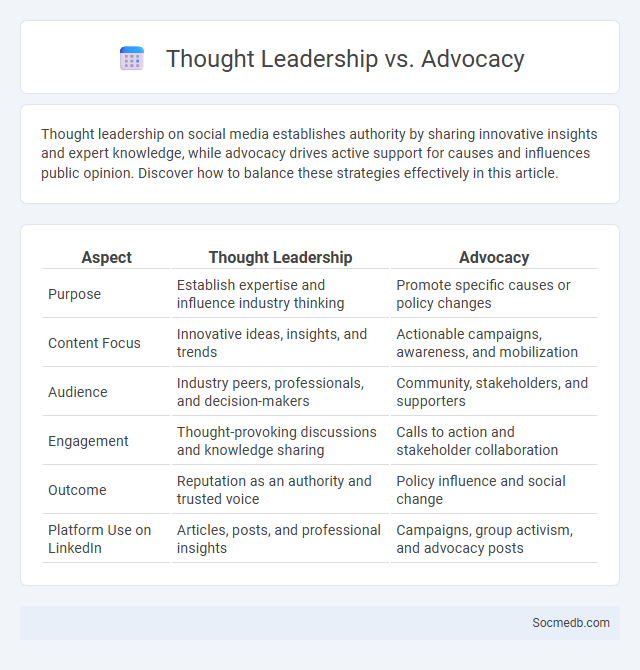
Photo illustration: Thought Leadership vs Advocacy
Thought leadership on social media establishes authority by sharing innovative insights and expert knowledge, while advocacy drives active support for causes and influences public opinion. Discover how to balance these strategies effectively in this article.
Table of Comparison
| Aspect | Thought Leadership | Advocacy |
|---|---|---|
| Purpose | Establish expertise and influence industry thinking | Promote specific causes or policy changes |
| Content Focus | Innovative ideas, insights, and trends | Actionable campaigns, awareness, and mobilization |
| Audience | Industry peers, professionals, and decision-makers | Community, stakeholders, and supporters |
| Engagement | Thought-provoking discussions and knowledge sharing | Calls to action and stakeholder collaboration |
| Outcome | Reputation as an authority and trusted voice | Policy influence and social change |
| Platform Use on LinkedIn | Articles, posts, and professional insights | Campaigns, group activism, and advocacy posts |
Understanding Thought Leadership
Thought leadership in social media establishes your authority by sharing insightful, relevant content that resonates with your target audience. Creating original ideas and engaging with industry discussions enhances your credibility and fosters trust among followers. Your consistent presence and expertise can position you as a go-to resource, driving influence and meaningful connections.
Defining Advocacy in Business
Advocacy in business refers to actively supporting and promoting a brand, product, or cause through genuine recommendations and endorsements, often driven by loyal customers or employees. Your social media presence can harness advocacy by encouraging authentic user-generated content and word-of-mouth referrals, enhancing trust and credibility. Leveraging social media advocacy boosts engagement, strengthens brand reputation, and drives organic growth through meaningful interactions.
Key Characteristics of Thought Leadership
Thought leadership in social media is characterized by consistent, insightful content that demonstrates expertise and innovative thinking within a specific industry. Influencers engage their audience through authentic storytelling, thought-provoking discussions, and valuable solutions, establishing trust and authority. Leveraging data-driven insights and multimedia formats enhances reach and reinforces their position as credible sources in niche markets.
Core Principles of Effective Advocacy
Effective advocacy on social media hinges on clarity, consistency, and engagement with your target audience. You must craft messages that are clear, authentic, and aligned with your cause to build trust and inspire action. Leveraging data-driven insights and actively interacting with followers amplifies your reach and impact.
Thought Leadership vs Advocacy: Main Differences
Thought leadership on social media centers on establishing expertise and sharing innovative insights to influence audience thinking, while advocacy focuses on actively supporting a cause or policy to drive social change. Thought leaders create valuable content that positions them as industry authorities, whereas advocates mobilize followers to take specific actions or support campaigns. Both strategies leverage social media's reach but serve distinct purposes: educating and inspiring versus motivating direct engagement and activism.
Roles and Impact in Organizational Growth
Social media drives organizational growth by enhancing brand visibility, fostering customer engagement, and enabling targeted marketing campaigns that boost conversion rates. Your business can leverage platforms like LinkedIn, Twitter, and Instagram to build a loyal community, gather real-time feedback, and amplify thought leadership. Strategic use of social media analytics helps identify trends and customer preferences, allowing organizations to tailor their offerings and improve overall performance.
Overlapping Areas: Where Advocacy Meets Thought Leadership
Social media platforms serve as dynamic intersections where advocacy and thought leadership converge, amplifying causes while establishing authority. Brands and influencers leverage these overlapping areas to engage audiences through meaningful content that drives social change and industry innovation simultaneously. This fusion enhances credibility, fosters community trust, and accelerates impact across digital ecosystems.
Case Studies: Successful Thought Leaders and Advocates
Case studies of successful thought leaders and advocates on social media reveal strategic content creation, authentic engagement, and consistent messaging as key drivers of influence and growth. Their use of targeted storytelling and data-driven insights enhances audience trust and loyalty while expanding reach within niche communities. By analyzing these examples, You can refine your approach to build a compelling digital presence that resonates and drives meaningful conversations.
Choosing the Right Approach for Your Brand
Selecting the optimal social media strategy requires understanding your brand's target audience, goals, and unique value proposition. Tailoring content to platform-specific behaviors and leveraging data analytics ensures maximum engagement and ROI. Your brand's consistent voice and authentic interactions build lasting connections that drive growth.
Future Trends: Evolving Roles of Thought Leadership and Advocacy
Future trends in social media highlight the growing influence of thought leadership and advocacy in shaping public discourse and brand identity. Platforms increasingly empower creators and activists to drive social change, leveraging authentic storytelling and niche community engagement. By aligning your social media strategy with these evolving roles, you position yourself to lead meaningful conversations and foster deeper audience connections.
 socmedb.com
socmedb.com